Chenhui Chu
Guiding Perception-Reasoning Closer to Human in Blind Image Quality Assessment
Dec 18, 2025Abstract:Humans assess image quality through a perception-reasoning cascade, integrating sensory cues with implicit reasoning to form self-consistent judgments. In this work, we investigate how a model can acquire both human-like and self-consistent reasoning capability for blind image quality assessment (BIQA). We first collect human evaluation data that capture several aspects of human perception-reasoning pipeline. Then, we adopt reinforcement learning, using human annotations as reward signals to guide the model toward human-like perception and reasoning. To enable the model to internalize self-consistent reasoning capability, we design a reward that drives the model to infer the image quality purely from self-generated descriptions. Empirically, our approach achieves score prediction performance comparable to state-of-the-art BIQA systems under general metrics, including Pearson and Spearman correlation coefficients. In addition to the rating score, we assess human-model alignment using ROUGE-1 to measure the similarity between model-generated and human perception-reasoning chains. On over 1,000 human-annotated samples, our model reaches a ROUGE-1 score of 0.512 (cf. 0.443 for baseline), indicating substantial coverage of human explanations and marking a step toward human-like interpretable reasoning in BIQA.
Language Lives in Sparse Dimensions: Toward Interpretable and Efficient Multilingual Control for Large Language Models
Oct 08, 2025Abstract:Large language models exhibit strong multilingual capabilities despite limited exposure to non-English data. Prior studies show that English-centric large language models map multilingual content into English-aligned representations at intermediate layers and then project them back into target-language token spaces in the final layer. From this observation, we hypothesize that this cross-lingual transition is governed by a small and sparse set of dimensions, which occur at consistent indices across the intermediate to final layers. Building on this insight, we introduce a simple, training-free method to identify and manipulate these dimensions, requiring only as few as 50 sentences of either parallel or monolingual data. Experiments on a multilingual generation control task reveal the interpretability of these dimensions, demonstrating that the interventions in these dimensions can switch the output language while preserving semantic content, and that it surpasses the performance of prior neuron-based approaches at a substantially lower cost.
Do LLMs Align Human Values Regarding Social Biases? Judging and Explaining Social Biases with LLMs
Sep 17, 2025Abstract:Large language models (LLMs) can lead to undesired consequences when misaligned with human values, especially in scenarios involving complex and sensitive social biases. Previous studies have revealed the misalignment of LLMs with human values using expert-designed or agent-based emulated bias scenarios. However, it remains unclear whether the alignment of LLMs with human values differs across different types of scenarios (e.g., scenarios containing negative vs. non-negative questions). In this study, we investigate the alignment of LLMs with human values regarding social biases (HVSB) in different types of bias scenarios. Through extensive analysis of 12 LLMs from four model families and four datasets, we demonstrate that LLMs with large model parameter scales do not necessarily have lower misalignment rate and attack success rate. Moreover, LLMs show a certain degree of alignment preference for specific types of scenarios and the LLMs from the same model family tend to have higher judgment consistency. In addition, we study the understanding capacity of LLMs with their explanations of HVSB. We find no significant differences in the understanding of HVSB across LLMs. We also find LLMs prefer their own generated explanations. Additionally, we endow smaller language models (LMs) with the ability to explain HVSB. The generation results show that the explanations generated by the fine-tuned smaller LMs are more readable, but have a relatively lower model agreeability.
How Does Cognitive Bias Affect Large Language Models? A Case Study on the Anchoring Effect in Price Negotiation Simulations
Aug 28, 2025Abstract:Cognitive biases, well-studied in humans, can also be observed in LLMs, affecting their reliability in real-world applications. This paper investigates the anchoring effect in LLM-driven price negotiations. To this end, we instructed seller LLM agents to apply the anchoring effect and evaluated negotiations using not only an objective metric but also a subjective metric. Experimental results show that LLMs are influenced by the anchoring effect like humans. Additionally, we investigated the relationship between the anchoring effect and factors such as reasoning and personality. It was shown that reasoning models are less prone to the anchoring effect, suggesting that the long chain of thought mitigates the effect. However, we found no significant correlation between personality traits and susceptibility to the anchoring effect. These findings contribute to a deeper understanding of cognitive biases in LLMs and to the realization of safe and responsible application of LLMs in society.
Bridging Speech Emotion Recognition and Personality: Dataset and Temporal Interaction Condition Network
May 20, 2025Abstract:This study investigates the interaction between personality traits and emotional expression, exploring how personality information can improve speech emotion recognition (SER). We collected personality annotation for the IEMOCAP dataset, and the statistical analysis identified significant correlations between personality traits and emotional expressions. To extract finegrained personality features, we propose a temporal interaction condition network (TICN), in which personality features are integrated with Hubert-based acoustic features for SER. Experiments show that incorporating ground-truth personality traits significantly enhances valence recognition, improving the concordance correlation coefficient (CCC) from 0.698 to 0.785 compared to the baseline without personality information. For practical applications in dialogue systems where personality information about the user is unavailable, we develop a front-end module of automatic personality recognition. Using these automatically predicted traits as inputs to our proposed TICN model, we achieve a CCC of 0.776 for valence recognition, representing an 11.17% relative improvement over the baseline. These findings confirm the effectiveness of personality-aware SER and provide a solid foundation for further exploration in personality-aware speech processing applications.
When Large Language Models Meet Speech: A Survey on Integration Approaches
Feb 26, 2025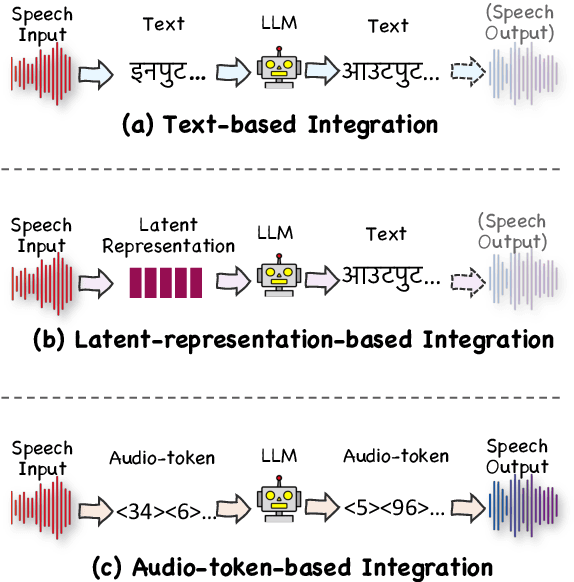
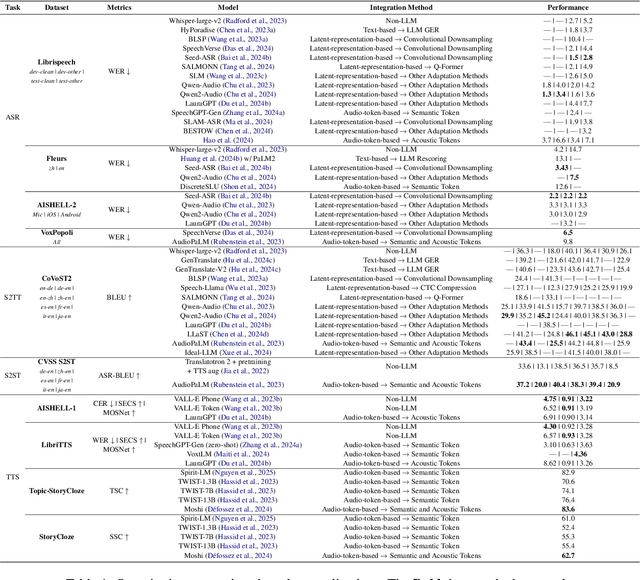
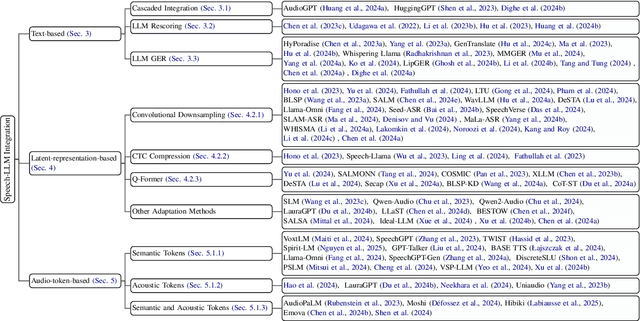
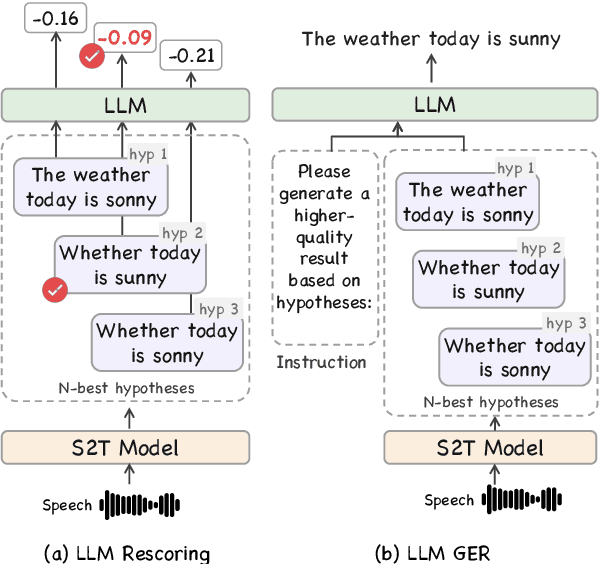
Abstract:Recent advancements in large language models (LLMs) have spurred interest in expanding their application beyond text-based tasks. A large number of studies have explored integrating other modalities with LLMs, notably speech modality, which is naturally related to text. This paper surveys the integration of speech with LLMs, categorizing the methodologies into three primary approaches: text-based, latent-representation-based, and audio-token-based integration. We also demonstrate how these methods are applied across various speech-related applications and highlight the challenges in this field to offer inspiration for
Cross-lingual Embedding Clustering for Hierarchical Softmax in Low-Resource Multilingual Speech Recognition
Jan 29, 2025



Abstract:We present a novel approach centered on the decoding stage of Automatic Speech Recognition (ASR) that enhances multilingual performance, especially for low-resource languages. It utilizes a cross-lingual embedding clustering method to construct a hierarchical Softmax (H-Softmax) decoder, which enables similar tokens across different languages to share similar decoder representations. It addresses the limitations of the previous Huffman-based H-Softmax method, which relied on shallow features in token similarity assessments. Through experiments on a downsampled dataset of 15 languages, we demonstrate the effectiveness of our approach in improving low-resource multilingual ASR accuracy.
Beyond English-Centric LLMs: What Language Do Multilingual Language Models Think in?
Aug 20, 2024

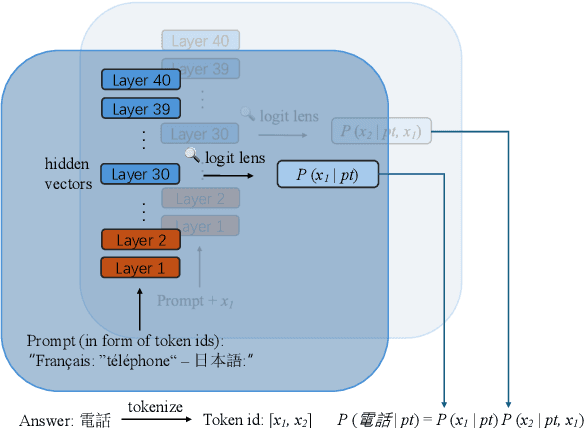
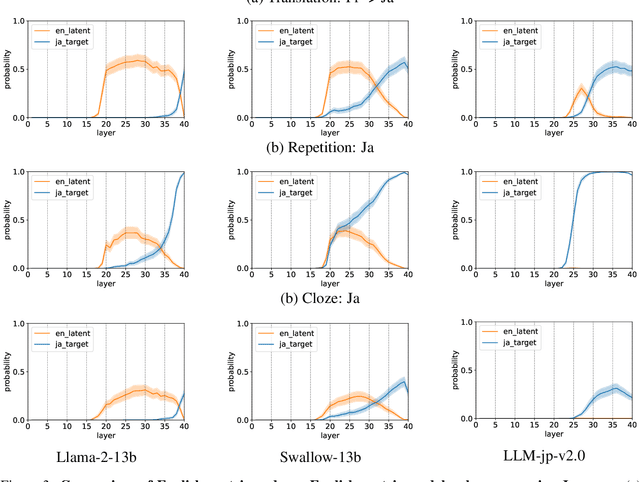
Abstract:In this study, we investigate whether non-English-centric LLMs, despite their strong performance, `think' in their respective dominant language: more precisely, `think' refers to how the representations of intermediate layers, when un-embedded into the vocabulary space, exhibit higher probabilities for certain dominant languages during generation. We term such languages as internal $\textbf{latent languages}$. We examine the latent language of three typical categories of models for Japanese processing: Llama2, an English-centric model; Swallow, an English-centric model with continued pre-training in Japanese; and LLM-jp, a model pre-trained on balanced English and Japanese corpora. Our empirical findings reveal that, unlike Llama2 which relies exclusively on English as the internal latent language, Japanese-specific Swallow and LLM-jp employ both Japanese and English, exhibiting dual internal latent languages. For any given target language, the model preferentially activates the latent language most closely related to it. In addition, we explore how intermediate layers respond to questions involving cultural conflicts between latent internal and target output languages. We further explore how the language identity shifts across layers while keeping consistent semantic meaning reflected in the intermediate layer representations. This study deepens the understanding of non-English-centric large language models, highlighting the intricate dynamics of language representation within their intermediate layers.
StyEmp: Stylizing Empathetic Response Generation via Multi-Grained Prefix Encoder and Personality Reinforcement
Aug 05, 2024



Abstract:Recent approaches for empathetic response generation mainly focus on emotional resonance and user understanding, without considering the system's personality. Consistent personality is evident in real human expression and is important for creating trustworthy systems. To address this problem, we propose StyEmp, which aims to stylize the empathetic response generation with a consistent personality. Specifically, it incorporates a multi-grained prefix mechanism designed to capture the intricate relationship between a system's personality and its empathetic expressions. Furthermore, we introduce a personality reinforcement module that leverages contrastive learning to calibrate the generation model, ensuring that responses are both empathetic and reflective of a distinct personality. Automatic and human evaluations on the EMPATHETICDIALOGUES benchmark show that StyEmp outperforms competitive baselines in terms of both empathy and personality expressions.
MELD-ST: An Emotion-aware Speech Translation Dataset
May 21, 2024Abstract:Emotion plays a crucial role in human conversation. This paper underscores the significance of considering emotion in speech translation. We present the MELD-ST dataset for the emotion-aware speech translation task, comprising English-to-Japanese and English-to-German language pairs. Each language pair includes about 10,000 utterances annotated with emotion labels from the MELD dataset. Baseline experiments using the SeamlessM4T model on the dataset indicate that fine-tuning with emotion labels can enhance translation performance in some settings, highlighting the need for further research in emotion-aware speech translation systems.
 Add to Chrome
Add to Chrome Add to Firefox
Add to Firefox Add to Edge
Add to Edge